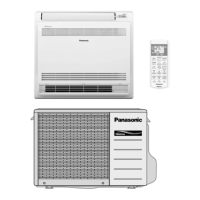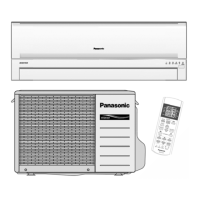Why is my Panasonic CS-E9GKEW not cooling efficiently in cooling mode?
- Jjordan84Aug 20, 2025
Inefficient cooling in your Panasonic Air Conditioner could be related to the compressor. Measuring gas side pressure can help to check its condition.

Why is my Panasonic CS-E9GKEW not cooling efficiently in cooling mode?
Inefficient cooling in your Panasonic Air Conditioner could be related to the compressor. Measuring gas side pressure can help to check its condition.
What to do if Panasonic CS-E9GKEW Air Conditioner shows total running current protection?
If the total running current protection is triggered on your Panasonic Air Conditioner, it may occur 3 times within 20 minutes. You should check for excess refrigerant and improper heat radiation.
Why does my Panasonic CS-E9GKEW show outdoor compressor overheating protection?
If your Panasonic Air Conditioner is experiencing outdoor compressor overheating protection, this might occur 4 times within 20 minutes. In such cases, check for insufficient refrigerant and the compressor itself.
What to do if my Panasonic CS-E9GKEW has a refrigeration cycle abnormal?
If your Panasonic Air Conditioner is showing a refrigeration cycle abnormality, it may occur 2 times within 20 minutes. Check for no refrigerant, ensuring the 3-way valve is not closed.
What causes cool high pressure protection in Panasonic CS-E9GKEW Air Conditioner?
If your Panasonic Air Conditioner displays a cooling high pressure protection error, it may occur 4 times within 20 minutes. Inspect the outdoor refrigerant circuit.
How to troubleshoot outdoor compressor abnormal revolution in Panasonic Air Conditioner?
If your Panasonic Air Conditioner is experiencing an outdoor compressor abnormal revolution, it may happen 4 times within 20 minutes. You should check the outdoor compressor.
Why is there a cooling / heating cycle changeover abnormality in my Panasonic Air Conditioner?
If your Panasonic Air Conditioner is having issues with cooling or heating cycle changeover, it may occur 4 times within 30 minutes. Check the 4-way valve and V-coil.
What to do if Panasonic CS-E9GKEW displays indoor fan motor mechanism lock?
If the indoor fan motor mechanism is locked on your Panasonic Air Conditioner, this may occur 7 times continuously. Check the indoor PCB and fan motor.
How to fix outdoor Direct Current (DC) peak detection in Panasonic Air Conditioner?
If there is an outdoor direct current peak detection issue with your Panasonic Air Conditioner, this may occur 7 times continuously. Check the outdoor PCB, IPM (Power transistor), and compressor.
What to do if Panasonic Air Conditioner has outdoor heat exchanger temperature sensor abnormality?
If your Panasonic Air Conditioner is showing an abnormality with the outdoor heat exchanger temperature sensor, allow it to continue for 5 seconds. Check the outdoor heat exchanger temperature sensor for defects or disconnections.
| Type | Split System |
|---|---|
| Heating Capacity | 3.2 kW |
| Power Supply | 220-240 V, 50 Hz |
| Coefficient of Performance (COP) | 3.80 |
| Noise Level (Outdoor) | 47 dB(A) |
| Refrigerant | R410A |
| Indoor Unit Dimensions (W x H x D) | 870 x 290 x 204 mm |
| Indoor Unit Weight | 9 kg |
| Outdoor Unit Weight | 30 kg |
| Cooling Capacity | 2.5 kW |
| Noise Level (Indoor) | 38 dB(A) |
Detailed technical specifications for the indoor unit models.
Detailed technical specifications for the outdoor unit models.
Identifies controls and components on the indoor unit.
Identifies controls and components on the outdoor unit.
Details the buttons and display of the remote control unit.
Provides physical dimensions for the indoor unit and remote control.
Provides physical dimensions for the outdoor unit.
Details the wiring connections for the indoor unit.
Details the wiring connections for the outdoor unit.
Illustrates the electronic circuit layout for the indoor unit.
Illustrates the electronic circuit layout for the outdoor unit.
Diagrams of the main, power, and indicator PCBs for indoor units.
Diagrams of the outdoor unit's printed circuit board.
Key points to check before and during installation.
Details changes in the shape and tightening method of 3-way valve caps.
Details maximum allowable piping lengths and additional refrigerant requirements.
Guidelines for choosing optimal indoor and outdoor unit placement.
Detailed steps for installing the indoor unit, including plate mounting and piping.
Guidance on installing the outdoor unit and connecting piping.
Rules for operating multiple indoor units concurrently.
Explanation of inverter control, temperature settings, and thermostat control.
How to use the Auto OFF/ON button for auto operation, test run, and mode selection.
Procedure to select and store remote control transmission codes.
Details functions of SET, CLOCK, RESET, TIMER buttons on the remote.
Diagnosing issues related to pressure, temperature, and electric current.
How to access and interpret error codes displayed by the unit.
Step-by-step guide to disassemble indoor unit components.
Step-by-step guide to disassemble outdoor unit components.
Graphs showing unit performance under various conditions.
Visual breakdown of indoor unit parts with a corresponding list.
Visual breakdown of outdoor unit parts with a corresponding list.












